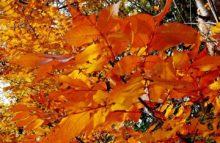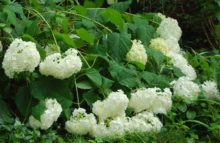Have you noticed fewer butterflies in your garden in 2020? For me, the bees h
ave been plentiful, including the native ones, but butterflies of any sort? Rema
rkably few.
It’s probably not just in my garden, or just in Toronto. A garden friend in Washington, D.C., commented on the same thing. And an
other Facebook commenter noted that people in the Northeast were also experiencing butterfly no-shows.
Was it our cold snap in May? This extended heatwave and drought? I’m sure it’s a complex formula.
World Wildlife Fund, for example, thi
no prescription pharmacy
s spring posted about the 53% decrease in area occupied by monarch butterflies in their Mexican wintering site during 2019/20. Cold spring temperatures were amongst the many reasons why. And there is this troubling report from the Center for Biological Diversity that graphs the downward trend in monarch pop
ulations since 1994.
How are things where you are?





39 comments
I have definitely noticed fewer butterflies in my garden. I am hoping it is because the main flush of flowers is only just beginning and that when I have more blooms they will come. But it is certainly concerning.
In Toronto, I think it was particularly noticeable due to the May severe cold snap just before we would have seen Red Admirals aplenty and overwintering butterflies like Mourning Cloak. The Monarchs and various swallowtails are just starting to appear, mid July. That’s late! And not as plentiful as last year, which in my garden was a bumper year for Monarch cats.
I know a few people who have seen Monarchs in their gardens in St. Catharines but I have not and I have all the right plants. I saw some Swallowtails about a month ago.
The modifiers you’re using tell a tale in themselves – “a few people” and “some.” At about the time my Quick Fire hydrangea blooms, as it is right now, it’s usually humming with all sorts of pollinators, including butterflies. Today, all I saw were bees and wasps. *insert sad emoji here*
Definitely fewer butterflies in Toronto this year. I work in a variety of gardens and have maybe seen a half a dozen to date? I always think when the zinnias come out I will see more, so I have my fingers crossed now that they are blooming that more will appear.
My zinnias haven’t had any butterfly visitors yet. Fingers crossed, though.
More swallowtails in our garden this year. Monarchs not around so far.
Good to hear about the swallowtails, Gail. I saw a couple and one Monarch yesterday. Maybe they’re just late?
Like you we’ve noticed lots of bees but very few butterflies. Just
2 sightings each of swallowtails and monarchs.
Let’s keep our eye peeled for more!
Surprizingly, I have more butterflies than normal and I feel like there are less bees. That being said, our bee hotel had only 2 rooms booked last summer and we seem to be getting close to a full house this year.
Interesting, Dianne. Let’s wave a few in each others’ way.
Perhaps because they’re a big focus of my photography I’ve seen quite a few. Monarchs were slower to arrive but I photographed chomping caterpillars up here in Muskoka yesterday. Spring weather was tough this year, followed by our intense heat wave.
Janet, are you getting quite the same crazy weather as in town up north?
Western Maryland: Very few butterflies, but bees of all sorts. And it’s mid July and I’ve yet to hear crickets or cicadas, which are the ‘music’ of a summer evening. I’ve seen maybe 10 Japanese beetles (usually by mid June any number of plant varieties are decimated by 100s of them). Very few fireflies. So, overall, a strange insect season so far. Disturbing!
That confirms what I’ve heard about the northeast, Ginny.
Cicadas are just now starting to emerge, late July.
Same in my Danforth garden. A few butterflies but not a single Monarch spotted yet and there were lots last year. I have all the butterfly friendly plants too.
Things must be late this year. Or the butterflies were listening! After writing this post, they’ve started to flit into my garden, though not in the numbers I’ve had before. Hope this is changing for you, too, Laurie!
Plenty of bees, a few butterflies, definitely no monarchs. However this morning I found two teeny baby monarch caterpillar babies on some of my new milkweed (planted mid June). It gives me hope, I so wanted to support the monarch population but wasn’t sure how to attract them. Sadly I noticed a third was dead and being dragged away by a tiny red beetle. Hoping the others fare better.
My milkweed is swarming with yellow aphids. If you have any tips on removing/treating For aphids without harming the baby ‘pillars, I’d love some tips! (Or a link if you have a blog post that discusses it?) thanks! Happy I found your blog, and I’m excited to do more reading.
Have you considered raising the caterpillars yourself? In a controlled environment? It’s a fascinating process to observe, from tiny caterpillars to hatched butterflies! Not at all difficult to do.
Ginny, I’ve reared monarchs once for educational purposes. But we do have to be careful about raising wild things, even butterflies, in captivity. There are restrictions and caveats to be aware of, and in Toronto we’re limited by the numbers of caterpillars we can host.
Jess, if aphids are a problem, you could try gently ripping off the leaf where the caterpillar is feeding then zapping the plant with a sharp spray from your hose to knock off the invaders. Afterwards, gently paperclip the torn leaf back onto the plant. The cat should eventually make its way back onto the main plant.
We have an abundance of pollinators, although they were late arriving/emerging with our cooler and wetter than usual spring. But now we are in full spring. In fact I have seen more Monarchs in my garden this year than any summer before.
Glad to hear it, Karin. As you’re in Georgia, you’d be seeing them much earlier than here in T.O. But, hopefully, they’re on their way in greater numbers.
Yes less insects of all kinds. not only the cold snap people were home due to covid and cleaned up their yards, removing wintering insects.
We need to promote home owners to leave a section of their yard piled with leaves, sticks, trees and debris to allow overwintering beneficial insects to prosper. Baby birds in the spring need the insects to survive without insects they starve to death. People clean up the yard after May 24.
Good point about yard cleanups, Pat! That’s something to educate people about.
Hello Helen.. I seem to have lots of bees .. and a few butterflies .. for now.
But I will really be able to tell when my hydrangea tree blooms next month .. that is when I had clouds of Monarchs dining on that nectar .. if I don’t see what I saw last year, then yes … there is a sad difference. I hope not.
I usually have a similar experience when my hydrangea opens, Joy, but it has been mostly bees and wasps, with a scant few butterflies. Still holding out hope that the few that dropped by this week come back for more.
Not sure about Toronto but on our property in Trent Hills (between Warkworth and Campbellford) I see an abundance of Swallowtails and Monarchs.
Sounds like people further from larger urban areas are being visited by more butterflies, Jennifer. I’m happy for you! And for the butterflies.
I have only seen a few monarchs so far, but this spring I was surprised to see hundreds of Baltimore Checkerspot caterpillars on the turtlehead plants. No butterflies yet though. I also have a few million soldier beetles which I have never seen before. They are on everything. Strange year for sure. In the country near Guelph.
Must plant turtlehead!
Although pollinators were later than usual to arrive in my garden, I’ve had many Monarchs and Swallowtails. I’m in Eastern Ontario and we also had a late freeze and an extremely dry summer.
Nancy, eventually the Monarchs and Swallowtails began to visit here, too, but in much fewer numbers than in 2019. Now it’s officially fall, it looks like the Monarchs began to migrate earlier than usual, too.
A local park in Longueuil near Montreal had lots of monarch butterflies in its milkweed patches last year but none this year…so sad…
Janny, let’s hope for better things in the future!
Piedmont area of NC has had fewer butterflies. I have one monarch caterpillar but never saw any monarchs that I saw. Tiger swallowtails seem more abundant than anything else. We had quite a few honeybees earlier in the season so I was thankful for that. Marjie
The bees have continued to be quite active here. And I saw more black swallowtails than the tigers, along with some monarchs. But no monarch cats on my milkweed at all!